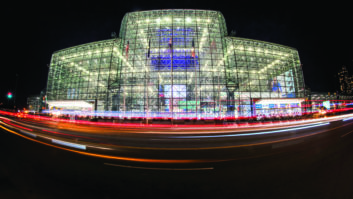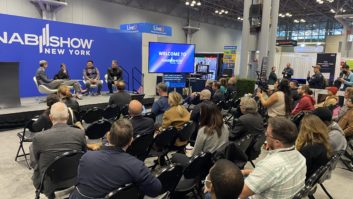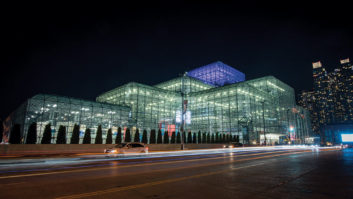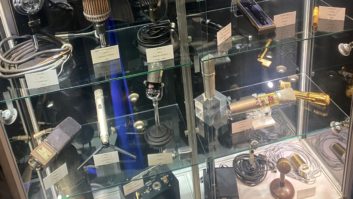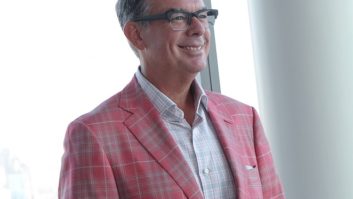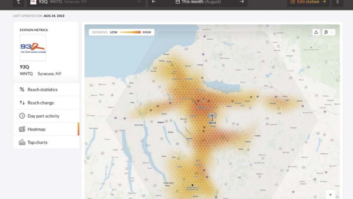
John Lyons provides information about the One World Trade Center broadcast transmission facilities to tour attendees. Photo: Scott Fybush
Whatever your connection to audio or video, if you could walk out of New York’s Javits Center Wednesday without finding something to catch your eye (or ear), you weren’t trying very hard. The combination of the Audio Engineering Society’s long-running New York show and the more recent evolution of the NAB New York show brought together a little something for just about anyone, all packed into two connected exhibit halls and a warren of meeting rooms downstairs.
The NAB side of the show evolved from a TV convention, so there’s still plenty of video and lighting to be seen there, but those are technologies we radio folks need to learn now, too, as we were reminded in an all-star AES session Wednesday afternoon on the latest trends in studio design.
Four walls aren’t enough anymore, because few of us are just doing “radio,” as presenters such as Telos’ Kirk Harnack, Max Media’s Daniel Hyatt and independent consultant Gary Kline reminded us. Sightlines are vitally important, Kline pointed out, not just so that your air talent and producers can all work together but also so that everything looks great on video as well as sounding great on audio. Still using incandescent lighting? The latest LED technology not only looks much better on video, Hyatt said, but also saves money on power bills. (We’ll be writing more about all of this in RW soon!)
Wednesday’s biggest event on the AES side (and the reason you’re not seeing this until Thursday morning) didn’t happen at the Javits, though. Seven miles downtown and 90 stories above lower Manhattan, veteran New York engineer John Lyons opened the doors at One World Trade Center for a presentation and tour for about 60 visiting engineers.
Most of New York’s TV broadcasters have signed on with the Durst Organization (where Lyons is VP of broadcasting) to relocate to the new 1WTC mast after spending the last 16 years transmitting from the rival Empire State Building. The first of those stations, Telemundo’s WNJU, signed on from 1WTC over the summer. It will soon have plenty of company: transmitters are now in place on the 90th floor for at least three more stations, with Fox getting ready to start building out its facility there very soon.
Think you know what a modern TV plant looks like? This new space might change your mind. For one thing, it’s quiet enough that Lyons was able to give a slide show about the construction right in the middle of the transmitter room — everything here is liquid-cooled and almost silent. For another, it’s all in one big room that wraps around the south side of the tower. Instead of individual transmitter spaces bursting with equipment as in the old days, each station has just a single row of equipment — a few locked racks next to today’s relatively compact transmitters. (Rohde & Schwarz is the brand of choice for most; CBS went with GatesAir, in part because of the close relationship they had with Harris in getting WCBS-TV back on the air right after 9/11.)
Combiners sit at the other end of the space, feeding VHF and UHF master antennas high above.
And as we rode back uptown toward the Javits and a late dinner, it was hard not to miss Empire, too, which was lit up in AES signature blue for the convention.






